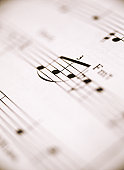
Home > Music Theory > Understanding Time Signatures
|
||||
Understanding Time Signatures
Some songs have mixed meters, which indicate the time signature changes over the course of the song. Any changes to the time signature are listed in front of the bar it changes. Understanding time signatures is more important from a composition standpoint than a performance standpoint. The two numbers in the time signature have different meanings to how the bars in the song are divided up. The bottom number indicates a type of note. For example, “4” indicates a quarter note, “2” indicates a half note and “8” indicates an eighth note. The top number of the time signature indicates the number of those notes that are in each bar. For example, a 4/4 song has four quarter notes per each bar, a 3/4 song has three quarter notes per each bar and a 4/2 song has four half notes per each bar. The time signature does not change the duration of notes. In some cases, time signatures could be the same length, but written as different time signatures. For example, a bar is four beats long in the 4/4 or 2/2 time signatures. The 6/8 time signature occasionally crops up, which is three beats per bar like a 3/4 song. The use of different time signatures does have a meaning from a composition standpoint.
This is one of the instances where understanding time signatures does not have a huge impact on performance or song composition. As long as you have the correct number of beats per bar, writing the best signature from a music theory standpoint does not make much of a difference. The most common aspect performers have to deal with is the stress patterns of a song. In almost all cases, the first beat of each bar is stressed. If the bar can be divided into four parts, the third beat is also usually stressed. However, the way the notes are stressed can vary. In some cases, the composed stresses these beats by placing chords into them. In other instances, the notes might be stressed by an accent, which means the note is played louder than normal. In many songs, the composer assumes the musician playing the song is automatically going to stress these beats and omits writing any notation to indicate a stressed note. If in doubt, the two best options are to play the song as written, even if there are no stresses written, or to accent the first beat of each bar by playing the note a little louder than normal. The difficulty of understanding time signature varies between different musicians. Most contemporary musicians only need to understand 4/4 and 3/4 time signatures. More elaborate time signatures crop up more for classically trained musicians. One good way to practice learning time signatures is to take a song and avoid looking at the time signature. Pick a random bar in the middle of the song and try to figure out what the time signature for that song is.
=> http://pianoplayerworld.com/Hanon1.html
| ||||
|
Although every attempt has been made to make information as accurate as possible, we are not responsible for any errors that may appear.
 The time signature of a song is shown as two numbers at the very beginning of
the song. The number of notes in each bar of music is indicated by this signature. Most modern songs have a
time signature of 4/4 or 3/4. Different time signatures are more commonly found in classical music,
The time signature of a song is shown as two numbers at the very beginning of
the song. The number of notes in each bar of music is indicated by this signature. Most modern songs have a
time signature of 4/4 or 3/4. Different time signatures are more commonly found in classical music, 
 A 4/4 song is usually based around quarter note rhythms, while a 2/2 song is
usually based around half note rhythms. The reason that quarter note time signatures are so common is because
most drum work revolves around quarter note rhythms.
A 4/4 song is usually based around quarter note rhythms, while a 2/2 song is
usually based around half note rhythms. The reason that quarter note time signatures are so common is because
most drum work revolves around quarter note rhythms.



